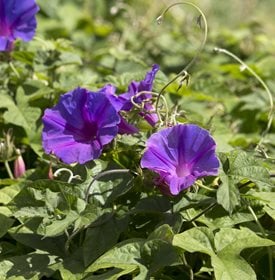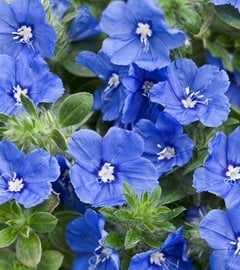Growing Morning Glory Vines
How to grow and care for fast-growing, easy-care morning glory flowersMorning glory vines bring old-fashioned charm and a quaint cottage feeling to any garden. However, if you don’t have time to take care of an aggressively seeding plant, you might want to think twice about introducing them into your garden, as they can get out of hand in a hurry. If you have a space where they can run wild over a fence, pergola or arbor, they will make quick cover of it. Their funnel or tubular-shaped flowers open in the morning and close in the afternoon. If you’re up for the challenge, here’s more information on growing morning glories.
On this page: The Basics | Planting Instructions | Care | Pictures | Design Tips
- MORNING GLORY BASICS
- PLANTING INSTRUCTIONS
- MORNING GLORY CARE
- LILY OF THE VALLEY TYPES
- LANDSCAPE DESIGN TIPS
MORNING GLORY BASICS
Zones:
Annual in areas that get below 45 F, but can still reseed and come back year after year on their own; perennial in warmer, more tropical climates.
Height/Spread:
6 to 12 feet, or more depending on variety.
Exposure:
Full sun
Bloom Time:
June to October
Color:
Varieties available in purple, blue, red, white, pink and bi-colored.
Toxicity:
Morning glory seeds are highly toxic if ingested.
Are morning glory vines invasive?
Morning glories are often mistaken for their aggressive and invasive cousin, field bindweed (Convolvulus arvensis), also called creeping Jenny, but they are two different species. Morning glories are from the family Ipomoea and, yes, can also be hard to handle and stubborn. They grow quite rapidly and will aggressively self-seed if not prevented by cutting back and removing seed pods, and some varieties have been declared invasive in certain areas. Field bindweed, on the other hand, sends out deep roots that make it nearly impossible to get rid of. These deep roots also allow it to overwinter in colder climates to return again and again. Field bindweed blooms in white or pink flowers and usually has smaller leaves than morning glory.
PLANTING INSTRUCTIONS
When to plant:
Morning glories are easily grown from seed and can be started indoors four to six weeks before the last spring frost. If sown directly into the garden, plant after any threat of frost and once the ground has warmed up to 64 F.
Where to plant:
Pick a site that gets plenty of sun. They will tolerate some very light shade, but bloom their best in full sun. Because of their rapid growth, choose a location that will allow for its mature size. Morning glories will readily self-seed if allowed, so make sure they are in an area that is accessible for cutting back spent blooms before they go to seed or an area where self-seeding is acceptable. Be considerate of neighboring yards and where the seeds might fall.
How to plant:
If planting from seed, file seeds to break the outer shell and soak for 24 hours prior to planting to help with germination. Cover lightly with one-quarter to one-half inch of soil and water thoroughly. When transplanting, be careful of the roots, as they don’t like being disturbed. Water deeply for several days after transplanting to help the roots get established in their new home. Helpful hint: If starting from seed, use peat or other disintegrating pots that can be planted directly in the soil to lessen the stress on the root system.
Other:
Morning glories grow quite rapidly once established, up to 12 feet or more in one season.
MORNING GLORY CARE
Pruning:
No pruning is required; but to prevent unwanted self-seeding, old flowers should be thoroughly removed before they form seedpods.
Soil:
Morning glories prefer moderately fertile, well-drained soil that is kept consistently moist until the plant is well established. Adult plants aren’t as picky about their soil and can tolerate poor, dry conditions.
Amendments & Fertilizer:
Although usually not necessary, you can apply a balanced liquid fertilizer monthly during growing season. Be careful not to fertilize too much as this can produce more foliage than flowers.
Watering:
Water freely during growing season and once or twice a week during dry periods; but again, established morning glory plants can tolerate drier conditions. Cut back watering in winter.
Propagation:
Softwood cuttings of perennial species can be rooted in spring or summer. Harvest mature seeds in the fall.
Diseases and Pests:
Morning glory vines are sturdy and not generally affected by disease or pests, but can occasionally be susceptible to white blister, rust, fungal leaf spot, stem rot, and wilt. They can also be bothered by aphids, leaf miners, spider mites, and caterpillars.
Other:
Deer will eat morning glory leaves and vines, although the seeds are poisonous.
MORNING GLORY PICTURES
All morning glories should be grown with care and you should check for locally invasive species. Here are a few of the more widely acceptable types:
LANDSCAPE DESIGN TIPS
- Morning glory vines will quickly cover trellises, pergolas, arches and fences.
- Use them to create a colorful wall or to cover an unsightly area.
- Fashion a living fence, porch or deck railing.
- Plant vines in containers with a supporting trellis.
- Drape out of a hanging basket; they will also twine up the hangers.
- Grow responsibly in areas where reseeding is acceptable.
- Some varieties are considered invasive in certain areas, check locally before planting.
FOR SOMETHING NEW, TRY DWARF MORNING GLORY
For true blue color in the landscape, few plants can rival the vivid blue flowers of dwarf morning glory (Evolvulus). A close relative of the more typical vining morning glory, evolvulus plants are more compact, producing mounds of fuzzy silvery-green foliage topped with 1/2-inch trumpet shaped flowers. This heat lover blooms nonstop from planting until frost, pairing well with most other flower and foliage colors.
Evolvulus prefers full sun and is drought tolerant once established. The mounding spreading habit is versatile in containers, for pathway and border edging, or massed in the landscape. Like other morning glories, the flowers close up in the afternoons or during hotter weather.
Varieties of dwarf morning glory include Blue My Mind® and Blue My Mind® XL, which has a more vigorous growth habit.
RELATED:
Flowering Vines
16 Surprisingly Drought-Tolerant Plants
21 Easiest Flowers for Beginners













